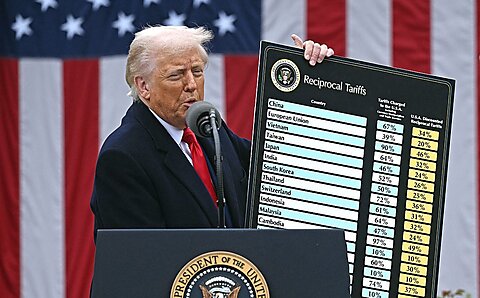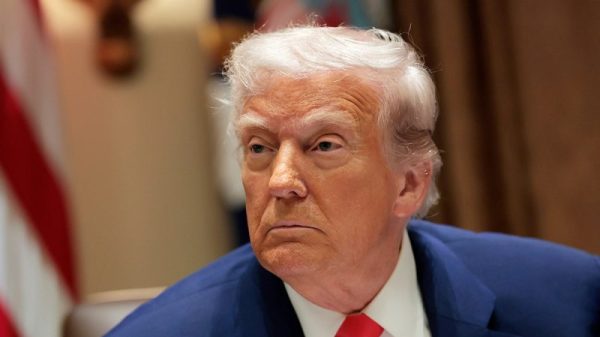Colin Grabow, Scott Lincicome, and Kyle Handley
For all of President Donald Trump’s talk about reciprocity, it turns out that he just wanted higher tariffs. After weeks of threatening “reciprocal” tariffs to match the higher tariffs and trade barriers of US trading partners, Trump announced yesterday that the United States was slapping a 10 percent tariff on everyone. Dozens more countries face still higher tariffs—up to 50 percent—for alleged trade transgressions.
The result appears to be the highest US tariffs since 1909, already ten times the size of those in place before Trump took office and at an average rate exceeding even that imposed by the infamous Smoot-Hawley Act, which is widely blamed for prolonging the Great Depression. Early analysis suggests the tariff hike amounts to an annual tax increase of over $100 billion per year, with income- and growth-sapping effects sure to be felt by virtually all Americans. And, of course, it was all imposed with mere days’ notice and without any congressional input or public comment.
So how, pray tell, did the Trump administration arrive at massive tariffs that it alleges offset foreign trade barriers of an equivalent amount?
You have to read it to believe it.
An Unserious (at Best) Approach to “Reciprocity”
As our colleagues Jeremy Horpedahl and Phil Magness detailed, the administration—by its own admission—did not conduct a careful and thorough analysis of foreign tariff and nontariff barriers that necessitate such a huge tax hike. Instead, the US Trade Representative’s office admits it simply assumed that US trade deficits—overall and with individual trading partners—reflect tariff and non-tariff factors that “prevent trade from balancing” and then calculated a tariff rate to bring bilateral trade into equilibrium.
Yet no serious international economist would make such an assumption. As Cato scholars and many others have long documented, trade balances are in general driven not by trade policies but by savings and investment (which are themselves driven by policy and non-policy factors). And bilateral trade balances are even less relevant because of trade with third countries, as well as global supply chains, embedded services, and international capital flows. To bluntly use a bilateral trade balance as a proxy for, in one White House official’s words, “trade cheating” makes no sense.
Believe it or not, it gets worse. In particular, the White House’s tariff rate calculation is barely more sophisticated than dividing the bilateral trade deficit between the United States and each trading partner by the quantity of goods imported into the United States, and then (completely at random) further dividing it by 2. Presto, there’s your “reciprocal” tariff rate.
White House officials counter that their formula is more complex than this, but—as Horpedahl and Magness note—this is far from exculpatory. In particular, the two additional variables the “official” calculation uses—tariff pass-through to domestic prices and the elasticity of demand for imports—coincidentally offset each other (with values of 0.25 and 4, respectively). They’re also unsupported in the economics literature: Not only is the elasticity value contradicted by even the very paper the USTR cites, but no serious economist would apply one number for all countries and all products because there is no one elasticity to rule them all. If this formula were applied only to, say, Vietnam, it might plausibly be a shortcut to calculating a tariff that zeroes out the bilateral trade balance, but not when applied to everyone at the same time.
It’s all economic witchcraft. Basing the tariff numbers on a ritualistic reading of entrails would have been as rigorous as the administration’s methodology.
And, as the following examples show, the results are tragicomic:
- Brazil, traditionally considered to have relatively high trade barriers (as even the White House admits) was hit with the same 10 percent tariff as free trade exemplar—and US FTA partner!—Singapore. Why? Because the United States currently runs a goods trade surplus with Brazil.
- The islands of Saint Pierre and Miquelon are facing a whopping 50 percent tariff for the trade crime of exporting $3.4 million worth of goods while importing a mere $100,000 of US products.
- Mauritius, which features a trade-weighted average tariff of just 1.3 percent, faces “reciprocal” tariffs of 40 percent.
- The uninhabited Australian territory of Heard Island and McDonald Islands faces 10 percent tariffs, while Norfolk Island (population: 2,188), another Australian territory, will be hit with 29 percent duties.
You cannot make this up.
Unfortunately, there are even more problems with the White House’s approach. Most notably, it excludes any cuts to US tariffs or trade barriers, which can in many cases be quite high, to match those of countries with more open economies. “Reciprocity” apparently was a mere marketing gimmick for the higher tariffs that Trump has long desired. Heads they win; tails you lose.
As disappointing as this outcome is, we can’t say we’re surprised. As we have pointed out for weeks now, exhaustively analyzing foreign trade barriers and producing matching US tariff rates would take many months, if not longer. And the president’s longstanding and misguided affection for tariffs (disdain for trade deficits) isn’t exactly a secret. That the White House would quickly produce intellectually honest—and in some cases net liberalizing—reciprocal tariff numbers without resorting to guesstimates and risible shortcuts in their calculations was never plausible.
And now Americans will bear the burden of this slipshod approach and its bogus results.
The Economic and Legal Damage
Beyond the billions in new taxes, these tariffs—and others Trump has imposed in recent weeks—will inevitably harm the economy.
Most obviously, vast swathes of goods and everyday products ranging from automobiles to apples will increase in price, placing added pressure on family budgets. Businesses, including the manufacturers Trump ostensibly seeks to promote, will see critical inputs become costlier with ensuing harm to their competitiveness. (Recall that around half of all imports are manufacturing inputs.) Foreign retaliation resulting from Trump’s moves will inflict further harm on American farmers and other exporters. And massive policy uncertainty—now three times the levels it was during Trump’s first term—will sap domestic business investment.
There will, of course, be some beneficiaries of Trump’s tariff hike, but—contra the spin—it won’t primarily be middle-class Americans or struggling small businesses. Instead, it’ll be politically connected companies and unions that have long lobbied for tariff protection or ones that can secure special exemptions. It’ll be Washington influence peddlers who will no doubt do brisk business attempting to secure those exceptions or encourage the administration to apply new restrictions on their clients’ overseas competition. And it’ll be US geopolitical rivals who will see their reputations shine as America’s grows tarnished, and their economic influence grows as we attack our friends and retreat from the global stage. Free trade deals and long-standing alliances, many are now learning, are worth little in President Trump’s eyes.
That this economic self-immolation, meanwhile, is being justified under the International Emergency Economic Powers Act—designed for use to address extraordinary and unusual threats—further compounds the sham. Mere months ago, The Economist declared the US economy “the envy of the world”—understandably so given the country’s record high family wealth, GDP per capita, surging equities markets, and numerous other economic indicators.
Yet the president would have us believe the United States is in a grave crisis? The absurdity is almost unbounded.
Trump’s “Liberation Day” tariffs are an incredible self-inflicted wound. It’s just unclear whether the greatest harm will be to the country’s economy, its reputation and standing, or the rule of law.




























